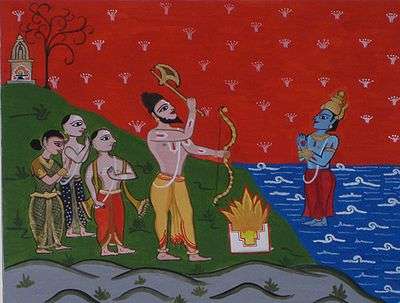Goud Saraswat Brahmin
| Regions with significant populations | |
|---|---|
| Primary populations in Karnataka, Goa, Maharashtra and Kerala[1] | |
| Religion | |
| Hinduism | |
| Related ethnic groups | |
| Saraswat Brahmins |
Goud (also spelt as Gaud or Gawd) Saraswat Brahmins are a Hindu Brahmin community in India and a part of the larger Saraswat Brahmin community. They belong to the Pancha (five) Gauda Brahmana groups. They are popularly referred to by the acronym GSB. They primarily speak Konkani as their mother tongue.

History
According to the Sahyadrikhanda of the Skanda Purana, ninety-six Saraswat Brahmin families belonging to ten gotras migrated to Goa from western India, along with Parashurama.[2][3] Reference to Saraswat names are found in Shilaharas as well as Kadamba copper plate inscriptions.The inscriptions found in Goa bear testimony to the arrival of Brahmin families in the Konkan region.[4]
The Shilahara kings seem to have invited so-called pure Aryan Brahmins and Kshatriyas from Indo-Gangetic valley in the north to settle in Konkan. These castes are the Gaud Saraswat Brahmins and CKP.[5]
Sahyadrikhanda and Mangesh Mahatmya allude to migrations of Saraswat Brahmins, constituting sixty-six families, who settled in eight villages of Goa. There were regional variations among the Saraswats, such as those among Bardeskars, Pednekars and Sastikars. The Konkana mahatmya, from the 17th century CE, deals with the internal rivalry of the Saraswats and strained relations between these groups.In Kalhana's Rajatarangini (12th century CE), the Saraswats are mentioned as one of the five Pancha Gauda Brahmin communities residing to the north of the Vindhyas.[6]
The GSB ancestors identified themselves as of the Saraswat section of the northern Gaud division, in contrast to their Maharashtra and Karnataka Brahman neighbors of the southern division. Many Saraswats left Goa after the invasion of Malik Kafur to the neighbouring regions and during the period of religious persecution of the Portuguese also Saraswats migrated to Uttar Kannada, Dakshina Kannada and North Konkan. The Saraswat Brahmins particularly served as Administrators,village revenue collectors (Kulkarnis), financiers,landlords,Priests,Teachers and Merchants in the intra-Asian trade, and diplomats. Many sources of government income in Goa, Konkan and elsewhere, including taxes on commodities and customs duties, remained in their hands.[4]
People
See also
References
- ↑ Lola Nayar (1 October 2012). "The Konkan Rail". Outlook India. Retrieved 8 October 2016.
- ↑ Shree Scanda Puran (Sayadri Khandha) -Ed. Dr. Jarson D. Kunha, Marathi version Ed. By Gajanan shastri Gaytonde, published by Shree Katyani Publication, Mumbai
- ↑ Gomantak Prakruti ani Sanskruti Part-1, p. 206, B. D. Satoskar, Shubhada Publication
- 1 2 Pinto, Celsa (1994). Trade and Finance in Portuguese India: A Study of the Portuguese Country Trade, 1770–1840 (Volume 5 of Xavier Centre of Historical Research Porvorim: XCHR studies series ed.). Concept Publishing Company. pp. 53–56. ISBN 9788170225072.
- ↑ Raj Pruthi, Rameshwari Devi (2004). Religions And Faiths In India. Mangal Deep Publications. p. 204.
There was a craze in the southern and eastern countries for the importation of the supposed pure Aryan Brahmins and Kshatriyas from the indo-gangetic valley in the north..The silhara kings of Konkan also seem to have invited both brahmins and kshatriyas from the north for settling in the south about this time.They are the Gauda Sarasvata Brahmins and the Chandraseniya Kayastha Prabhus of Konkan.
- ↑ D. Shyam Babu and Ravindra S. Khare, ed. (2011). Caste in Life: Experiencing Inequalities. Pearson Education India. p. 168. ISBN 9788131754399.
Further reading
- Suryanath U Kamath (1992). The origin and spread of Gauda Saraswats.
- Venkataraya Narayan Kudva (1972). History of the Dakshinatya Saraswats. Samyukta Gauda Saraswata Sabha.
- Ramachandra Shyama Nayak. "Saraswath Sudha".
- Kawl, M. K. Kashmiri Pandits: Looking to the Future.
- Bryant, Edwin (2001). The Quest for the Origins of Vedic Culture. Oxford University Press. ISBN 0-19-513777-9.
- Hock, Hans (1999) "Through a Glass Darkly: Modern "Racial" Interpretations vs. Textual and General Prehistoric Evidence on Arya and Dasa/Dasyu in Vedic Indo-Aryan Society." in Aryan and Non-Aryan in South Asia, ed. Bronkhorst & Deshpande, Ann Arbor.
- Shaffer, Jim G. (1995). "Cultural tradition and Palaeoethnicity in South Asian Archaeology". In George Erdosy. Indo-Aryans of Ancient South Asia. ISBN 3-11-014447-6.
- Conlon, Frank F. (1974). "Caste by Association: The Gauda Sarasvata Brahmana Unification Movement". The Journal of Asian Studies. 33 (3): 351–365. doi:10.2307/2052936. JSTOR 2052936. (Subscription required (help)).